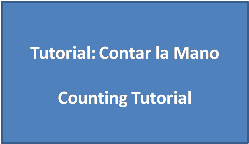Source: http://rfrick.info/bridge/index.htm
How to Count
Suppose you are defending. If you started the hand with 3 spades and the dummy started with 4 spades, and you find out the declarer had 1 spade, you can figure out how many spades your partner has. There are 13 spades. Subtract the three that you have, the four that dummy has, and the one that declarer has, and you get that your partner started the hand with 5 spades. Or you can add up the 3, 4, and 1 spades that you know about, getting 8, and subtract that from 13.
As you may have noticed, that is adding and subtracting, not counting. The technical term in bridge is counting, but for goodness sakes you should not actually be counting.
In fact, you should not be adding or subtracting either. There are only so many bridge distributions. One is the 5-4-3-1 distribution. The order of the numbers doesn’t matter — it might appear to you as the 5-4-1-3 distribution, the 3-4-1-5 distribution, or whatever. The point is, your brain should know that these four numbers go together, and when it hears three of these numbers, it should supply the fourth.
Developing this skill requires practice. That practice is not enjoyable. But counting out a hand is enough work as it is. To save yourself time and energy, you can’t be also adding and subtracting.
So do it. Use flash cards. Practice in your head. Practice while standing in the grocery line. Give yourself three numbers, and practice knowing the fourth. This doesn’t take forever to learn. Once you learn, you can use it and it will become a habit.
Of course, you just need to know the common distributions; if someone has an 8-card suit, you can make a special occasion for adding and subtracting. Start off with the most common distributions — 4-3-3-3 and 4-4-3-2. Add in 5-3-3-2, 4-4-4-1, and 5-4-3-1. You are mostly there.
Not only do all the suits have 13 cards, but all the hands have 13 cards too. If you learn that declarer started with 1 spade, 5 hearts, and 4 diamonds, you can infer that declarer started with 3 clubs.
There is another point to notice about counting distribution. When you start out, you know your distribution and the dummy’s. But — again assuming your are defending — you don’t know declarer’s spades, declarer’s hearts, declarer’s diamonds, declarer’s clubs, partner’s spades, partner’s hearts, partner’s diamonds, and partner’s clubs. In a sense you are missing eight pieces of information.
But, if you learn declarer’s spades, you know partner’s spades; if you learn declarer’s hearts, you know partner’s hearts, and if you know declarer’s diamonds, you know partner’s diamonds. And once you know those three suits you can figure out the fourth suit.
So you start the hand missing only 3 pieces of information. Once you know three pieces of information, you can figure out the complete distribution of the hand. That is why you can count the distribution more often than you otherwise might expect, and that is why counting distribution is the foremost type of counting.
The Exercises
In these exercises on counting, I take you part way through the hand, then ask you to count. The classic thing to count is distribution. The second thing to count is high-card points (HCP). That is less likely to be successful than counting distribution, and not as easy as counting distribution, but sometimes it is useful. Finally, it sometimes helps to count winners.
Your goal is to count as much as you can. First, try to figure out the distribution. Second, try to count points and place the high cards. When relevant, try to count winners. It’s practice; the more you do it, the easier it gets.
All of these hands are from real life. (If I alter the hand, I will let you know.) Sometimes you can count things out, and sometimes you can’t. You usually will be defender, partially because declarer gives up a lot of information in the bidding.
Once you have counted everything you can, then the problem is what you should do. Frankly, counting is sometimes a waste of time, meaning that you end up doing what you would have done if you hadn’t counted. But there is a different way of thinking about the hand once you have counted, and sometimes that leads to a different answer.
Enough. Try [ilink url=”http://csbnews.org/new/?p=44652″]a hand[/ilink] .
Esta entrada también está disponible en: Spanish

